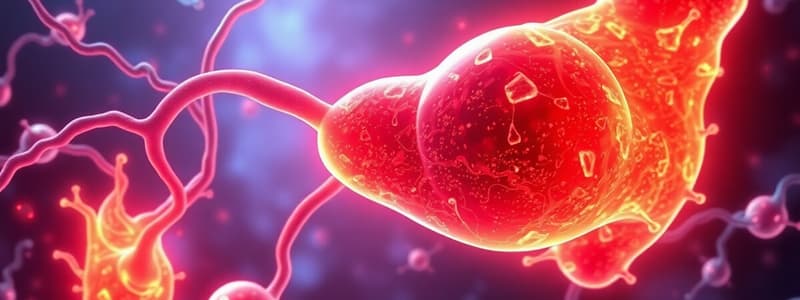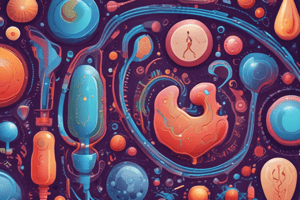Podcast
Questions and Answers
What is the waist circumference threshold for abdominal obesity in women?
What is the waist circumference threshold for abdominal obesity in women?
- 40 inches
- 30 inches
- 45 inches
- 35 inches (correct)
Which of the following is a major defect in the development of fasting hyperglycemia?
Which of the following is a major defect in the development of fasting hyperglycemia?
- Loss of glucose-induced insulin release (correct)
- Impaired glucagon release
- Increased insulin sensitivity
- Decreased levels of triglycerides
Which factor is NOT mentioned as a contributor to the pathogenesis of type 2 diabetes?
Which factor is NOT mentioned as a contributor to the pathogenesis of type 2 diabetes?
- Age (correct)
- Diet
- Exercise
- Family history
What distinguishes type 1 diabetes from type 2 diabetes regarding body weight?
What distinguishes type 1 diabetes from type 2 diabetes regarding body weight?
At what blood pressure level is an individual considered to have a risk factor for cardiovascular disease?
At what blood pressure level is an individual considered to have a risk factor for cardiovascular disease?
What is the primary function of glucagon in carbohydrate metabolism?
What is the primary function of glucagon in carbohydrate metabolism?
Which of the following stimuli can increase glucagon secretion?
Which of the following stimuli can increase glucagon secretion?
What effect does glucagon have on lipid metabolism?
What effect does glucagon have on lipid metabolism?
How does glucagon affect protein metabolism?
How does glucagon affect protein metabolism?
What occurs as a result of glucagon administration?
What occurs as a result of glucagon administration?
Which hormones work alongside glucagon to regulate blood glucose levels?
Which hormones work alongside glucagon to regulate blood glucose levels?
What leads to the inhibition of glucagon secretion?
What leads to the inhibition of glucagon secretion?
Which statement is true regarding glucagon's effect on gluconeogenesis?
Which statement is true regarding glucagon's effect on gluconeogenesis?
What is the primary physiological effect of epinephrine during stress?
What is the primary physiological effect of epinephrine during stress?
What is the primary role of cortisol in glucose metabolism?
What is the primary role of cortisol in glucose metabolism?
How does growth hormone affect blood glucose levels?
How does growth hormone affect blood glucose levels?
Which of the following hormones has a minimal effect on glucose metabolism?
Which of the following hormones has a minimal effect on glucose metabolism?
What defines diabetes mellitus?
What defines diabetes mellitus?
What condition is defined as the normal range for plasma glucose concentration after an overnight fast?
What condition is defined as the normal range for plasma glucose concentration after an overnight fast?
What is a common physiological cause of transient hyperglycemic states?
What is a common physiological cause of transient hyperglycemic states?
Which hormone is primarily synthesized by the adrenal medulla?
Which hormone is primarily synthesized by the adrenal medulla?
Which type of diabetes is primarily characterized by insulin insensitivity at target tissues?
Which type of diabetes is primarily characterized by insulin insensitivity at target tissues?
What is a consequence of the destruction of beta cells in Type 1 diabetes?
What is a consequence of the destruction of beta cells in Type 1 diabetes?
Which category of diabetes is typically associated with pregnancy?
Which category of diabetes is typically associated with pregnancy?
What is insulin resistance syndrome also known as?
What is insulin resistance syndrome also known as?
Which condition is NOT considered a criteria for diagnosing metabolic syndrome?
Which condition is NOT considered a criteria for diagnosing metabolic syndrome?
What is the common age of onset for Type 2 diabetes?
What is the common age of onset for Type 2 diabetes?
Which factor is most attributed to the pathogenesis of Type 2 diabetes?
Which factor is most attributed to the pathogenesis of Type 2 diabetes?
What role does obesity play in the development of Type 2 diabetes?
What role does obesity play in the development of Type 2 diabetes?
Flashcards are hidden until you start studying
Study Notes
Glucagon
- Glucagon is a polypeptide hormone secreted by the α-cells of the pancreatic islets of Langerhans.
- Glucagon, in conjunction with epinephrine, cortisol, and growth hormone, acts primarily to maintain blood glucose levels.
- Glucagon achieves this by activating hepatic glycogenolysis (breakdown of glycogen) and gluconeogenesis (formation of glucose from non-carbohydrate sources).
- Glucagon secretion is stimulated by low blood glucose and amino acids.
- It is inhibited by elevated blood glucose and insulin.
Metabolic Effects of Glucagon
- Glucagon leads to an immediate rise in blood glucose levels.
- It activates lipolysis (breakdown of fat) in adipose tissue.
- Free fatty acids released are used for ketone body synthesis in the liver.
- Glucagon increases the uptake of amino acids by the liver, promoting gluconeogenesis.
Other Hormones Regulating Blood Glucose
- Epinephrine: synthesized by the adrenal medulla, released in response to hypoglycemia.
- Stimulates glycogenolysis and gluconeogenesis in the liver.
- Inhibits insulin release.
- Cortisol: glucocorticoid hormone produced by the adrenal cortex.
- Extended elevations lead to hyperglycemia.
- Increases gluconeogenesis and antagonizes insulin action.
- Growth Hormone (Somatotropin): produced by the anterior pituitary gland.
- Prolonged elevations result in hyperglycemia.
- Stimulates gluconeogenesis, enhances lipolysis, and antagonizes insulin function.
- Thyroxine: secreted by the thyroid gland.
- Plays a minor role in direct glucose regulation.
- Can promote glycogenolysis and deplete liver glycogen.
- May increase glucose absorption.
Alterations in Carbohydrate Metabolism
- Hyperglycemia is more prevalent than hypoglycemia.
- Normal fasting plasma glucose range is between 70-110 mg/dl.
- Non-fasting glucose range for individuals is between 70-150 mg/dl.
Diabetes Mellitus
- A group of metabolic diseases characterized by hyperglycemia.
- Caused by defects in insulin secretion, insulin action, or both.
- Categorized into four main types:
- Type 1 diabetes
- Type 2 diabetes
- Other specific types of diabetes
- Gestational diabetes mellitus (GDM)
Type 1 Diabetes Mellitus (Insulin-dependent diabetes mellitus)
- Characterized by destruction of beta cells in the pancreas, leading to an absolute insulin deficiency.
- Often diagnosed in childhood and adolescence.
- Requires insulin therapy.
- Subtypes:
- Autoimmune induced
- Idiopathic diabetes mellitus
- Latent autoimmune diabetes of adults (LADA)
Type 2 Diabetes Mellitus (T2DM)
- Most common type of diabetes.
- Characterized by insulin resistance at target tissues.
- Typically acquired after age 40, but can occur in younger individuals.
- Genetic factors play a role in the development of T2DM.
- Environmental factors, such as diet and obesity, are also influential.
- Often managed through dietary changes and weight loss.
- Insulin therapy may be needed in some cases.
Pathogenesis of Type 2 Diabetes
- Insulin Resistance:
- Decreased biological response to normal levels of insulin.
- Found in obese non-diabetic individuals and in patients with type 2 diabetes.
- Can be associated with the "insulin resistance syndrome" or "metabolic syndrome," which includes:
- Insulin resistance
- Hyperinsulinemia
- Obesity
- Dyslipidemia (high triglycerides and low HDL cholesterol)
- Hypertension
- Metabolic Syndrome:
- Diagnosed when an individual meets three or more of the following criteria:
- Abdominal obesity (waist circumference > 35 inches (women) or 40 inches (men))
- Triglycerides > 150 mg/dl
- HDL cholesterol < 50 mg/dl (women) or < 40 mg/dl (men)
- Blood pressure ≥ 130/85 mm Hg
- Fasting plasma glucose ≥ 110 mg/dl
- Increases the risk of cardiovascular disease.
- Diagnosed when an individual meets three or more of the following criteria:
- Loss of Beta Cells:
- Increased β cell demand due to insulin resistance is associated with a progressive loss of β cell function.
- This loss contributes to the development of fasting hyperglycemia.
- Characterized by a loss of glucose-induced insulin release, termed "selective glucose unresponsiveness."
- Environmental Factors:
- Diet and exercise are important contributors to the development of type 2 diabetes.
- All obese individuals, even those with normal carbohydrate tolerance, have hyperinsulinemia and insulin resistance.
- Family history, duration of obesity, and fat distribution are also important factors.
Comparing Type 1 and Type 2 Diabetes
| Feature | Type 1 Diabetes | Type 2 Diabetes |
|---|---|---|
| Synonyms | IDDM, juvenile onset | NIDDM, adult onset |
| Age of onset | Usually before 40 years of age | Usually after 40 years of age |
| Ketosis | Common | Rare |
| Body weight | Non-obese | Obese |
| Prevalence | 0.5% | 6-10% |
| Genetics | HLA associated | Non-HLA associated |
| Circulating islet cells | 50-85% | - |
Studying That Suits You
Use AI to generate personalized quizzes and flashcards to suit your learning preferences.




